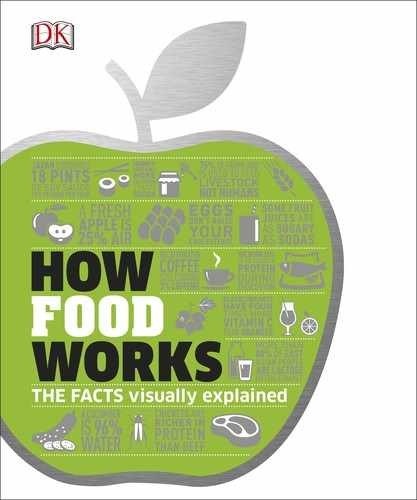
How hot is hot?
Chilies get their spicy heat from the chemical compound capsaicin. We measure
the capsaicin concentration of chilies and chili-derived products by using the
Scoville scale, devised by Walter Scoville in 1912. The scale originally indicated
how many times a chili extract had to be diluted before its heat became
imperceptible to a panel of five tasters. Today the Scoville scale has been
updated to provide a direct measurement of capsaicin levels, using scientific
analysis instead of subjectivity. In addition to creating this heat sensation,
capsaicin also disrupts the mitochondria (the cell’s power-stations). Cancer cells
are particularly vulnerable to this, so much so that capsaicin is being tested as
an anticancer drug. Other hot foods, such as horseradish and mustard, get their
heat from pungent, volatile compounds, and can be judged on a pungency scale.
Chilies and
other hot foods
Prized for adding kick to dishes, chili peppers and other hot
or pungent foods, such as mustard and horseradish, come
armed with powerful chemical defenses that we can use for
flavor but that may also prove to have health benefits.
The Scoville scale
The traditional chart topper was the habanero, but
in recent years, new breeds of superhot chili
peppers have been created with Scoville ratings of
over 2 million. Precise levels vary from plant to
plant and even between individual chilies.
RED SAVINA HABANERO
350,000–580,000
BHUT JOLOKIA
855,000–1.5 MILLION
TRINIDAD MORUGA SCORPION
1.5–2 MILLION
CAROLINA REAPER
1.5–2.2 MILLION
CAN CHILIES
AID WEIGHT LOSS?
Research in mice found
that capsaicin helped convert
white fat to healthier brown
fat; other research suggests
that chili reduces cravings
for fat and sugar.
16 MILLION
THE SCOVILLE
HEAT UNITS IN
PURE CAPSAICIN
580,000
1.5 MILLION
2.2 MILLION
US_128-129_Chill_and_Hot_Foods.indd 128 18/01/2017 11:14
128 129
TYPES OF FOOD
Chilies and other hot foods
TONGUE
NASAL CAVITY
Taste bud
in tongue
stimulated
To brain
To brain
Mustard
Receptor
nerve in
nasal cavity
stimulated
Vapor
molecule
C
H
E
M
I
C
A
L
S
T
I
M
U
L
A
T
I
O
N
What causes the heat?
Capsaicin stimulates heat-sensing nerve
cells, so that the brain receives heat signals
and the body is stimulated to respond as if
burned, even though there is no actual
chemical damage (from regular
consumption; capsaicin is a neurotoxin
in large enough doses). Horseradish,
mustard, and wasabi are rich in
glucosinolates. When the plant is
crushed, enzymes break these
down into isothiocyanates, the
compounds that give these foods
their heat.
The heat sensation
Mustard and chilies are both hot, but we feel
them in different ways. Chilies feel hot on
the tongue because capsaicin stimulates the
nerve receptors in the mouth. As well as being
somewhat water-soluble, the isothiocyanates
in mustard evaporate easily, even at room
temperate, so we feel the burn in the upper
nasal cavities, where receptors are stimulated.
The capsaicin in chilies is not soluble
in water, so drinking lots of cold water
will not help. But it is soluble in fat,
so drinking milk or eating ice cream
should help to dissolve and dilute
the irritant chemicals. In addition, the
casein proteins in milk may help break
the bonds between capsaicin and
nerve receptors. Strong alcohol, such
as spirits, might also help. Capsaicin
can be removed from skin with
vegetable oil or butter.
RELIEVING THE BURNING
SWEET BELL PEPPER
NO SIGNIFICANT
HEAT
SERRANO
PEPPER
10,000–23,000
CAYENNE PEPPER
30,000–50,000
BIRD’S EYE CHILI
50,000–100,000
SCOTCH BONNET PEPPER
100,000–350,000
RED SAVINA HABANERO
350,000–580,000
0
30,000
10,000
50,000
100,000
350,000
MILK
ICE
CREAM
Chili
SCOVILLE HEAT UNITS
(
SHU
)
US_128-129_Chill_and_Hot_Foods.indd 129 23/02/2017 11:41

128 129
TYPES OF FOOD
Chilies and other hot foods
TONGUE
NASAL CAVITY
Taste bud
in tongue
stimulated
To brain
To brain
Mustard
Receptor
nerve in
nasal cavity
stimulated
Vapor
molecule
C
H
E
M
I
C
A
L
S
T
I
M
U
L
A
T
I
O
N
What causes the heat?
Capsaicin stimulates heat-sensing nerve
cells, so that the brain receives heat signals
and the body is stimulated to respond as if
burned, even though there is no actual
chemical damage (from regular
consumption; capsaicin is a neurotoxin
in large enough doses). Horseradish,
mustard, and wasabi are rich in
glucosinolates. When the plant is
crushed, enzymes break these
down into isothiocyanates, the
compounds that give these foods
their heat.
The heat sensation
Mustard and chilies are both hot, but we feel
them in different ways. Chilies feel hot on
the tongue because capsaicin stimulates the
nerve receptors in the mouth. As well as being
somewhat water-soluble, the isothiocyanates
in mustard evaporate easily, even at room
temperate, so we feel the burn in the upper
nasal cavities, where receptors are stimulated.
The capsaicin in chilies is not soluble
in water, so drinking lots of cold water
will not help. But it is soluble in fat,
so drinking milk or eating ice cream
should help to dissolve and dilute
the irritant chemicals. In addition, the
casein proteins in milk may help break
the bonds between capsaicin and
nerve receptors. Strong alcohol, such
as spirits, might also help. Capsaicin
can be removed from skin with
vegetable oil or butter.
RELIEVING THE BURNING
SWEET BELL PEPPER
NO SIGNIFICANT
HEAT
SERRANO
PEPPER
10,000–23,000
CAYENNE PEPPER
30,000–50,000
BIRD’S EYE CHILI
50,000–100,000
SCOTCH BONNET PEPPER
100,000–350,000
RED SAVINA HABANERO
350,000–580,000
0
30,000
10,000
50,000
100,000
350,000
MILK
ICE
CREAM
Chili
SCOVILLE HEAT UNITS
(
SHU
)
US_128-129_Chill_and_Hot_Foods.indd 129 23/02/2017 11:41
..................Content has been hidden....................
You can't read the all page of ebook, please click here login for view all page.
